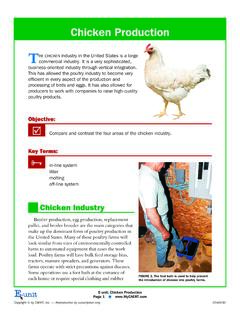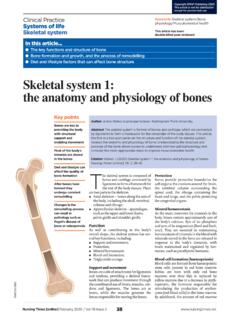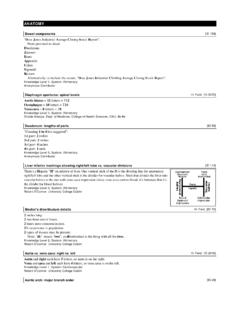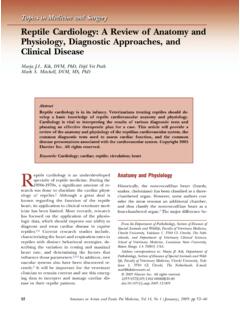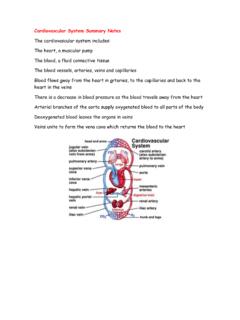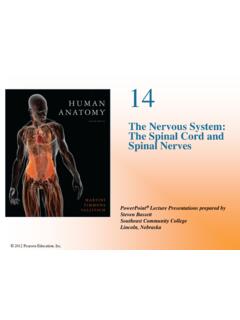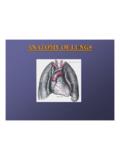Transcription of Flower Anatomy - carlisle.k12.ky.us
1 Flower AnatomyDID YOU KNOW that the plants most important toagriculture all produce flowers ? Every majorfood crop is a flowering plant. We do not thinkabout the flowers of wheat, rice, corn, andsoybeans. Maybe it is because they arenot as showy as the flowers of : Describe the parts of flowers and their functions, the types of flowers , and Terms: FlowersFlowers are the most obvious part of many plants. In some cases, they are extremely other cases, they are not easily seen. Whether they are showy or not, the purpose of a floweris for a plant to be able to reproduce : Flower AnatomyPage by CAERT, Inc. Reproduction by subscription flowercorollacorymbcymesdeterminatedioec iousfilamentheadimperfect flowerincomplete flowerindeterminateinflorescencemonoecio usovarypaniclepedicelpeduncleperfect flowerperianthpetalspistilpistillatepoll enracemereceptaclesepalsspadixspikestame nstaminatestigmastyletepalsumbelFLOWER PARTSF lowers are made of many intricate and important parts.
2 Most flowers contain male andfemale Flower PartsThe male part of the Flower is called thestamen. It is made of the stalk-likefilamentthatholds up the sack-likeanther. The anther containspollen, the grain released by flowers ,which contains the sperm. flowers that have male parts and no female parts are Flower PartsThe female part of the Flower is called thepistil. Thecarpelis the basic unit of thefemale reproductive organ, and a pistil may con-sist of one or more carpels. The carpel is com-posed of a stigma, style, and ovary. Thestigmais a sticky tissue at the end of the pistil that isreceptive to pollen. Located below the stigma isa rod-shaped middle part called thestyleand aswollen base (called theovary) that containseggs. Once the pollen reaches the stigma, itforms a pollen tube down through the style tothe ovary where sperm is deposited. Flowersthat have female parts and no male parts PartsFlowers have parts that are not classified asmale or female. Thepetals, usually colorfulleaf-like structures, attract animals and insects.
3 Sometimes the petals are fused together andform a structure called acorolla. Beneath the petals are green leaf-like structures calledsepals. The sepals support the petals and protect the Flower before it opens; the sepals may befused together to form acalyx. Together, the petals and the sepals are called some plants, a clear distinction between petals and sepals cannot be made. In these cases,the parts of the perianth are calledtepals. Tulip flowers and many monocots have plants have modified leaves at the base of a Flower or floral inflorescence called abract. The bracts may be green, but in some cases ( , the poinsettia) the bracts are Flower stem is referred to as thepedicel, and the portion of the pedicel that holds theflower parts is : Flower AnatomyPage by CAERT, Inc. Reproduction by subscription grains(contain sperm)StigmaStyleOvaryOvuleEgg cellPollinationFIGURE 1. The transfer of pollen to the OF FLOWERSF lowers come in many shapes, sizes, and colors.
4 Not all of them have all of the structuresmentioned may produce flowers that are perfect or imperfect. A Flower with male and femaleparts is called aperfect Flower . A Flower that is missing male or female parts is animper-fect may have flowers that are complete or incomplete. If a Flower has sepals, petals, pis-tils, and stamens, it is acomplete Flower . If a Flower is missing one of those, it is anincom-plete Flower . Imperfect flowers are always incomplete, but incomplete flowers may or maynot be may be classified as monoecious or have male andfemale flowers on one plant. Corn, cucumbers, and oaks are male and female flowers on separate plants. Soybeans, asparagus, kiwi, and hemp areexamples of dioecious good way to tell the difference between a monocot and a dicot is to look closely at theflowers. Monocots have flowers with Flower parts in multiples of three, and dicots have flow-ers with Flower parts in multiples of four or OF INFLORESCENCESF lowers are borne on plant stems in one of two ways.
5 Some plants have solitary flowers ,such as the tulip, narcissus, and rose. Other plants have Flower clusters, known as aninflores-cence, which is the stem s branching system. The main stem of an inflorescence is known asthepeduncle. Pedicels that branch from the peduncle support individual : Flower AnatomyPage by CAERT, Inc. Reproduction by subscription 2. Parts of a perfect of inflorescence can be classified by the sequence of flowering within the flowercluster. If the first Flower to open is at the apex of the stem and the progression of flowering isdownward or outward, the inflorescence is said to bedeterminate. Some examples of deter-minate flowers include liatris, kalanchoe, and the African violet. If the last Flower to open isterminal on the main axis and the progression of flowering is inward or upward, the inflores-cence isindeterminate. Indeterminate types of inflorescences are racemes, corymbs, heads,and umbels. Freesia, cineraria, snapdragon, and stock have indeterminate a variety of inflorescence types.
6 Some common types are cyme, spike, raceme, pani-cle, corymb, umbel, spadix, catkin, and head. The spike and the panicle types of inflorescenceare the most common among monocot on several forms, but cymes are usually flat-topped inflorescences. Dichasiumcymes bear terminal flowers on peduncles with a pair of branches that produce lateral may be simple or compound. Monochasium cymes have terminal flowers , and belowit, monochasium cymes have one branch that produces a single lateral Flower . The terminalflower is the oldest. Tomatoes, potatoes, and alstroemerias are cymes. Baby s breath is a com-pound dichasium : Flower AnatomyPage by CAERT, Inc. Reproduction by subscription 3. The arrangement of flowers on a an elongated inflorescence with a central axis where sessile flowers are , barley, ryegrass, wheatgrass, gladioli, and liatris are spike an elongated inflorescence with a central axis where simple pedicels of moreor less equal length are attached.
7 Examples of racemes include foxtail millet, snapdragon, del-phinium, Scotch broom, and an elongated inflorescence with a central axis where there are branches thatare themselves branched. Rice, oats, Sudan grass, Kentucky bluegrass, tall fescue, timothy,grain sorghum, astilbe, and begonia have a panicle a short and broad, flat-topped indeterminate inflorescence with a main verticalaxis and pedicels or branches of unequal length. The outer flowers open first. Yarrow is anexample of a an inflorescence with several branches arising from a common point. A simpleumbel consists of flowers with single pedicels. Compound umbels have secondary branchingin the form of pedicels at the end of a ray. Queen Anne s lace and amaryllis have a spike with a thickened, fleshy axis, usually enveloped by a showy bract calleda spathe. Floriculture crops with a spadix include the calla lily and a spike, raceme, or cyme composed of unisexual flowers without petals and fall-ing as a unit.
8 Catkins are found on willows, alders, oaks, and a rounded or flat-topped cluster of sessile flowers . Head inflorescences of theaster family resemble single flowers . These consist of centrally grouped flowers called discflowers encircled by ray flowers . Some common plants that have a head inflorescence aregerbera daisy, chrysanthemum, sunflower, marigold, dahlia, strawflowers, and :2 The purpose of a Flower is for a plant to be able to reproduce male part of the Flower (stamen) consists of a filament and an anther. Theanther contains pollen. The female part of the Flower (pistil) is composed of thestigma, style, and ovary. Other Flower parts include petals, sepals, bracts, pedicels,and may produce flowers that are perfect or imperfect and may have flowers thatare complete or incomplete. Plants may be classified as monoecious or have flowers with Flower parts in multiples of three. Dicots have flowerswith Flower parts in multiples of four or may be borne solitary, or they may be in Flower clusters (inflorescence).
9 Aninflorescence may be determinate or indeterminate. Some common inflorescencetypes are cyme, spike, raceme, panicle, corymb, umbel, spadix, catkin, and : Flower AnatomyPage by CAERT, Inc. Reproduction by subscription Your Knowledge: 1. What is the purpose of a Flower ?2. What are the male and female parts of a Flower ?3. What are complete, incomplete, perfect, and imperfect flowers ?4. How do monocot flowers differ from dicot flowers ?5. What is an inflorescence?Expanding Your Knowledge:LObtain flowers from different plants. Using a forceps and scalpel, carefully dissectthe flowers . Identify the floral parts, and then count the floral parts. Use a magnify-ing lens or microscope for a closer look at the Links::The Basics of (Maize) #figure19 flowers : Features of Flowering : Flower AnatomyPage by CAERT, Inc. Reproduction by subscription
